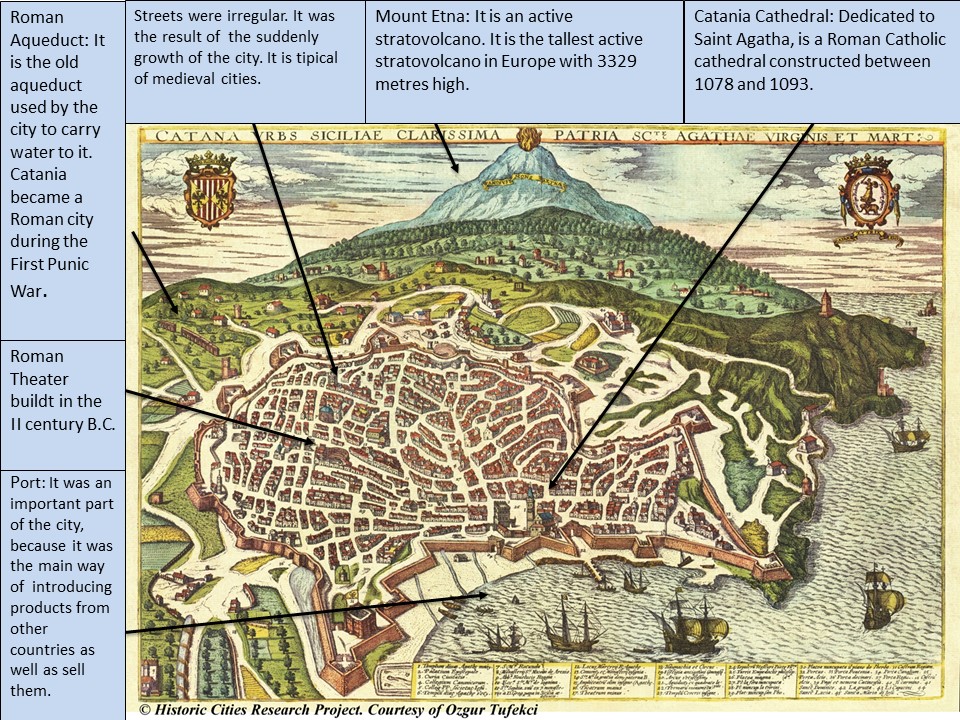CATANIA (Antonio Stizza, 1592)
The picture we are going to talk about was made by Antonio Stizza in 1592 and finally published in 1598, so it represents the city of Catania in the end of the 16th century.
Catania is a city located on the east coast of Sicily, Italy, next to the Ionian Sea. Catania is actually the capital of the Metropolitan area of Catania that is one of the biggest cities in Italy, and the second one in Sicily after Palermo. Catania was founded in the 8th century BC, as a Greek colony and it has been destroyed at least seven times because of the eruptions of Etna volcano and several earthquakes. It was also the first city of Sicily in having a university, that was founded in 1434 by Alfonso V of Aragón.
The Greek geographer Strabo said that the presence of the Mount Etna has bad and good things. On one hand, the eruptions of Etna caused a lot of suffering and destruction, but on the other hand the ashes made a fertile soil, especially good for the vines. Therefore, agriculture is one of the most important economic activities developed in Catania.
We must say that the city we know nowadays as Catania is not as the Catania that we see in the picture made by Stizza. First of all, in 1669 the city suffered the eruption of Mount Etna. The population was almost saved because the city walls stopped the lava and most of it diverted into the port. The eruption of the volcano was so terrible that even the Nicito lake, which was in the limits of the city, and had a circumference of around six kilometers was covered up with lava. The east part of the city was seriously damaged. What is more, in 1693 Catania suffered an earthquake that destroyed the city. Then, a big part of the city was reconstructed over the ruins of the old Catania, according to the Baroque architecture that nowadays characterizes it.
Catania has a subterranean river, the Amenano. When the Greeks founded Catania as a colony, they decided to establish their settlement there because it was at the edge of the Amenano river. After the earthquake of 1693 and the reconstruction of the city, the river was covered by the new city.
We can also see in the picture a clear example of a medieval city. As we can observe the streets looks narrow and disorganized. This is the result of a disordered growing. Another example that makes us think about Catania as a medieval city is the city walls. The city walls were important in those times because they were used for defense and, if someone wanted to introduce something inside, he was forced to pay taxes for it. In addition, the city walls stopped and diverted the progress of lava while the eruption of Mount Etna in 1669, as we said before. Nevertheless, the left part of the picture seems like having an orthogonal plan, maybe because the Romans established there a colony after the First Punic War until the decline of the Roman Empire in the 5th century.
One of the most important urban elements that we can see in the picture is the Cathedral dedicated to Saint Agatha, to be seen at the bottom. This Cathedral was originally constructed between 1078 and 1093, over the ruins of the Roman Achillean Baths, by order of King Roger I, who conquered the city from the Islamic Emirate of Sicily. However, the Cathedral was completely destroyed in 1693, as the result of the earthquake, so the Cathedral we can see nowadays is not the same because it was reconstructed in Baroque style. The bell tower was built in 1387 and it was 70 meters high. After the destruction of 1693 they added a huge bell of 7.5 tonnes, being the third biggest one in Italy.
The harbour is also is noticeable. It was was the main point for trading and getting new things that came from other countries. Greeks decided to establish there their colony because it was well-located, next to the Italian peninsula, and not so far away from Africa and Greece.
Another interesting place in Catania is the Castello Ursino that we can see in the left corner at the bottom of the city. It was built in the 13th century as a royal castle for the King of Sicily. After the Sicilian Vespers, the castle was the residence of Frederick III of Sicily, son of Peter III of Aragon who fought in the Sicilian Vespers against the French army commanded by Charles I of Anjou. The moat that was surrounding the castle was also filled up with lava after the huge eruption of Mount Etna in 1669.
Juan Martín Figueredo

